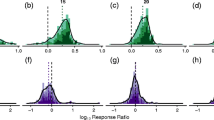Summary
Four concepts are considered for the trophic level of a species in a community food web. The long-way-up-level (or LU-level) of species A is the length of the longest simple food chain from a basal species (one with no prey in the web) to A. (A simple chain is a chain that does not pass through any given species more than once.) The short-way-up-level (SU-level) of species A is the length of the shortest chain from a basal species to A. The long-way-down-level (LD-level) of species A is the length of the longest simple chain from species A to a top species (one with no consumers in the web). The short-way-down-level (SD-level) of species A is the length of the shortest chain from species A to a top species. The stratigraphy of a web is the analogue for species of the ‘pyramid of numbers’ for individuals: it is the frequency distribution of species according to level. The LU-, SU-, LD-, and SD-stratigraphies of the seven webs in the Briand-Cohen collection with 30 or more trophic species reveal no species with LU-level or LD-level more than 6, no species with SU-level more than 3, and no species with SD-level more than 2. In all seven webs, SD-levels are stochastically less than SU-levels: species tend to be closer to a top predator than to a basal species. Two stochastic models of food web structure (the cascade model and the homogeneous superlinear model) correctly predict that 95% or more of species should have LU-level and LD-level in the range 0–6. The models also correctly predict some details of the distribution of species in the SU- and SD-stratigraphies, particularly the fraction of species in level 1. The models do not, in general, correctly predict the distribution of species within the range 0–6 of LU-levels and LD-levels.
Similar content being viewed by others
References
Bird, R. D. (1930) Biotic communities of the Aspen Parkland of central Canada.Ecology 11, 356–442.
Calder, W. A. (1984)Size, Function and Life History. Harvard University Press, Cambridge, MA, USA.
Cohen, J. E. (compiler) (1989)Ecologists' Co-Operative Web Bank. Version 1.0. Machine-readable Data Base of Food Webs. Rockefeller University, NY, USA.
Cohen, J. E. (1990) A stochastic theory of community food webs: VI. heterogeneous alternatives to the cascade model.Theor. Pop. Biol. 37, 55–90.
Cohen, J. E., Briand, F. and Newman, C. M. (1990)Community Food Webs: Data and Theory. Biomathematics, Vol. 20. Springer-Verlag, Berlin, Germany.
Cousins, S. H. (1980) A trophic continuun derived from plant structure, animal size and a detritus cascade.J. Theor. Biol. 82, 607–18.
Cousins, S. H. (1987) The decline of the trophic level concept.Trends Ecol. Evol. 2, 312–16.
Elton, C. (1927)Animal Ecology (New impression with additional notes, 1935). Macmillan, NY, USA.
Fryer, G. (1959) The trophic interrelationships and ecology of some littoral communities of Lake Nyasa.Proc. Lond. Zool. Soc.,132, 153–281.
Glynn, P. W. (1965) Community composition, structure, and interrelationships in the marine intertidalEndocladia muricata — Balanus glandula association in Monterey Bay, California.Beaufortia 12(148), 1–198.
Hairston, N. G., Smith, F. E. and Slobodkin, L. B. (1960) Community structure, population control and competition.Am. Nat. 94, 421–5.
Howard, L. O. (1897)A Study of Insect Parasitism. US Department of Agricultural Technical Series, Vol. 5, pp. 1–57.
Howes, P. G. (1954)The Giant Cactus Forest and Its World. Duell, Sloan and Pearce, NY, USA.
Lotka, A. J. (1925)Elements of Physical Biology. Williams and Wilkins, Baltimore, MD, USA.
Marshall, A. W. and Olkin, I. (1979)Inequalities: Theory of Majorization and Its Applications, Academic Press, NY, USA.
Martinez, N. (1991) Artifacts or Attributes? Effects of Resolution on the Little Rock Lake Food Web. Ecological Monographs (in press).
Paviour Smith, K. (1956) The biotic community of a salt meadow in New Zealand.Trans. R. Soc. N.Z. 83(3), 525–54.
Peters, R. H. (1983)The Ecological Implications of Body Size. Cambridge University Press, Cambridge, UK.
Pimm, S. L. (1982)Food Webs, Chapman & Hall, London, UK.
Pimm, S. L., Lawton, J. H. and Cohen, J. E. (1991) Food web patterns and their consequences.Nature 350, 669–74.
Polis, G., Myers, C. A. and Holt, R. D. (1989) The ecology and evolution of intraguild predation: potential competitors that eat each other.Ann. Rev. Ecol. Syst. 20, 297–330.
Rasmussen, D. I. (1941) Blotic communities of Kaibab Plateau, Arizona.Ecol. Monogr. 11, 228–75.
Robinson, D. F. and Foulds, L. R. (1980)Digraphs: Theory and Techniques. Gordon and Breach, NY, USA.
Schoener, T. W. (1982) The controversy over interspecific competition.Am. Sci. 70, 586–95.
Schoener, T. W. (1939) Food webs from the small to the large.Ecology 70, 1559–89.
Winemiller, K. O. (1990) Spatial and temporal variation in tropical fish trophic networks.Ecol. Monogr. 60, 331–67.
Wool, D. and Manheim, O. (1986) Population ecology of the gall-forming aphid,Aploneura lentisci, in Israel.Res. Popul. Ecol. 28, 151–62.
Yodzis, P. (1989)Introduction to Theoretical Ecology. Harper and Row, NY, USA.
Yodzis, P. (1991) Environment and trophodiversity. InHistorical and Geographical Determinants of Community Diversity (R. E. Ricklefs and D. Schluter, eds), University of Chicago Press, Chicago, IL, USA (in press).
Author information
Authors and Affiliations
Rights and permissions
About this article
Cite this article
Cohen, J.E., Łuczak, T. Trophic levels in community food webs. Evol Ecol 6, 73–89 (1992). https://doi.org/10.1007/BF02285335
Issue Date:
DOI: https://doi.org/10.1007/BF02285335




